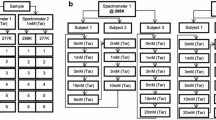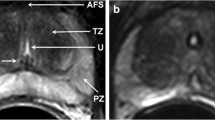Abstract
Introduction
Molecular interactions in prostatic fluid are of biological interest and may affect MRI and MRS of the prostate. We investigated the existence of interactions between the major components of this fluid: spermine, citrate and myoinositol, metal ions, including zinc, and proteins.
Materials and methods
Solutions of 90 mM citrate, 18 mM spermine and 6 mM myo-inositol, mimicking expressed prostatic fluid, were investigated by 1H NMR using changes in T2 relaxation and chemical shift as markers for interactions.
Results and discussion
Adding to this metabolite mixture the ions Na+ , K+, Ca++, Mg++ and Zn++, decreased the T2 relaxation times of citrate and spermine protons by factors of 3 and 2, respectively, with Zn++ causing the largest effect, indicating ion–metabolite interactions. The T2 of 18 mM spermine dropped by a factor of 2 upon addition with 90 mM citrate, but no effect on T2 was seen with myo-inositol pointing to a specific citrate-spermine interaction. Moreover, the T2 of citrate in the presence of spermine decreased by adding metal ions and increasing amounts of Zn++, indicating complexation of citrate and spermine with metal ions, particularly with Zn. The addition of bovine serum albumin (BSA), as an index protein, substantially further decreased the T2 of spermine and citrate implying the formation of a transient spermine-metal ion-citrate-BSA complex.
Finally, we found that the T2 of citrate in extracellular fluid of prostate cancer cells, as a mimic of fluid in cancerous prostates, decreased by adding fetal calf serum, indicating protein binding.





Similar content being viewed by others
References
Kurhanewicz J, Vigneron DB (2016) Magnetic resonance spectroscopy of prostate cancer. Emagres 5(1):923–943
Tayari N, Heerschap A, Scheenen TWJ, Kobus T (2017) In vivo MR spectroscopic imaging of the prostate, from application to interpretation. Anal Biochem. https://doi.org/10.1016/j.ab.2017.02.001
Kobus T, Vos PC, Hambrock T, Rooij MD, de Kaa CAH-V, Barentsz JO et al (2012) Prostate cancer aggressiveness. in vivo assessment of MR spectroscopy and diffusion-weighted imaging at 3 T. Radiology 265:457–467
van Asten JJA, Cuijpers V, Hulsbergen-van de Kaa C, Soede-Huijbregts C, Witjes JA, Verhofstad A et al (2008) High resolution magic angle spinning NMR spectroscopy for metabolic assessment of cancer presence and Gleason score in human prostate needle biopsies. Magn Reson Mater Phy 21:435–442
Tayari N, Wright AJ, Heerschap A (2021) Absolute choline tissue concentration mapping for prostate cancer localization and characterization using 3D 1H MRSI without water-signal suppression. Magn Reson Med 00:1–13
Gholizadeh N, Greer PB, Simpson J, Goodwin J, Fu C, Lau P, Heerschap A, Ramadan S (2021) Diagnosis of transition zone prostate cancer by multiparametric MRI: added value of MR spectroscopic imaging with sLASER volume selection. J Biomed Sci 28(1):54
Tuerkbey B, Bernardo M, Merino MJ, Wood BJ, Pinto PA, Choyke PL (2012) MRI of localized prostate cancer: coming of age in the PSA era. Diagn Interv Radiol 18:34–45
Lynch MJ, Nicholson JK (1997) Proton MRS of human prostatic fluid: Correlations between citrate, spermine, and myo-inositol levels and changes with disease. Prostate 30:248–255
Kline EE, Treat EG, Averna TA, Davis MS, Smith AY, Sillerud LO (2006) Citrate concentrations in human seminal fluid and expressed prostatic fluid determined via 1H nuclear magnetic resonance spectroscopy outperform prostate specific antigen in prostate cancer detection. J Urol 176:2274–2279
Fukatsu A, Ono Y, Ito M, Yoshino Y, Hattori R, Gotoh M et al (2003) Relationship between serum prostate-specific antigen and calculated epithelial volume. Urology 61:370–374
Cheng LL, Wu C, Smith MR, Gonzalez RG (2001) Non-destructive quantitation of spermine in human prostate tissue samples using HRMAS 1H NMR spectroscopy at 9.4 T. FEBS Lett 494:112–116
Serkova NJ, Gamito EJ, Jones RH, O’Donnell C, Brown JL, Green S et al (2008) The metabolites citrate, myo-inositol, and spermine are potential age-independent markers of prostate cancer in human expressed prostatic secretions. Prostate 68:620–628
Kavenagh J (1985) Sodium, potassium, calcium, magnesium, zinc, citrate and chloride content of human prostatic and seminal fluid. J Reprod Fertil 75:35–41
van der Graaf M, Heerschap A (1996) Effect of cation binding on the proton chemical shifts and the spin–spin coupling constant of citrate. J Magn Reson B 112(1):58–62
Moore G, Sillerud L (1994) The pH-dependence of chemical-shift and spin-spin coupling for citrate RID E-7184-2010. J Magn Reson B 103:87–88
Zaichick V, Zaichick S (2020) A systematic review of the trace element concentrations in the prostate fluid of normal gland. Am J Biomed Sci Res 6(6):001093. https://doi.org/10.34297/AJBSR.2020.06.001093
Zaichick VY, Sviridova TV, Zaichick SV (1996) Zinc concentration in human prostatic fluid: normal, chronic prostatitis, adenoma and cancer. Int Urol Nephrol 28:687–694
Zaichick S, Zaichick V (2013) Relations of morphometric parameters to zinc content in paediatric and nonhyperplastic young adult prostate glands. Andrology 1:139–146
Costello LC, Franklin RB (2008) Prostatic fluid electrolyte composition for the screening of prostate cancer: a potential solution to a major problem. Prostate Cancer Prostatic Dis 12:17–24
Spencer NG, Eykyn TR, deSouza NM, Payne GS (2010) The effect of experimental conditions on the detection of spermine in cell extracts and tissues. NMR Biomed 23:163–169
Li R, Guo Y, Han BM, Yan X, Utleg AG, Li W et al (2008) Proteomics cataloging analysis of human expressed prostatic secretions reveals rich source of biomarker candidates. Proteomics Clin Appl 2:543–555
Utleg AG, Yi EC, Xie T, Shannon P, White JT, Goodlett DR et al (2003) Proteomic analysis of human prostasomes. Prostate 56:150–161
Duncan MW, Thompson HS (2007) Proteomics of semen and its constituents. Proteomics Clin Appl 1:861–875
Drake RR, Elschenbroich S, Lopez-Perez O, Kim Y, Ignatchenko V, Ignatchenko A et al (2010) In-depth proteomic analyses of direct expressed prostatic secretions. J Proteome Res 9:2109–2116
Kim Y, Ignatchenko V, Yao CQ, Kalatskaya I, Nyalwidhe JO, Lance RS et al (2012) Identification of differentially expressed proteins in direct expressed prostatic secretions of men with organ-confined versus extracapsular prostate cancer. Mol Cell Proteomics 11:1870–1884
Drake RR, White KY, Fuller TW, Igwe E, Clements MA, Nyalwidhe JO et al (2009) Clinical collection and protein properties of expressed prostatic secretions as a source for biomarkers of prostatic disease. J Proteomics 72:907–917
Nagano K, Masters JR, Akpan A, Yang A, Corless S, Wood C et al (2003) Differential protein synthesis and expression levels in normal and neoplastic human prostate cells and their regulation by type I and II interferons. Oncogene 23:1693–1703
Ummanni R, Junker H, Zimmermann U, Venz S, Teller S, Giebel J et al (2008) Prohibitin identified by proteomic analysis of prostate biopsies distinguishes hyperplasia and cancer. Cancer Lett 266:171–185
Francis GL (2010) Albumin and mammalian cell culture: implications for biotechnology applications. Cytotechnology 62:1–16. https://doi.org/10.1007/s10616-010-9263-3
Bryan N, Andrews KD, Loughran MJ, Rhodes NP, Hunt JA (2011) Elucidating the contribution of the elemental composition of fetal calf serum to antigenic expression of primary human umbilical-vein endothelial cells in vitro. Biosci Rep 31(3):199–210
Vanhamme L, Van Den Boogaart A, Van Huffel S (1997) Improved method for accurate and efficient quantification of MRS data with use of prior knowledge. J Magn Reson 129:35–43
Stefan D et al (2009) Quantitation of magnetic resonance spectroscopy signals: the jMRUI software package. Meas Sci Technol 20:104035
Milon BC, Agyapong A, Bautista R, Costello LC, Franklin RB (2010) Ras responsive element binding protein-1 (RREB-1) down-regulates hZIP1 expression in prostate cancer cells. Prostate 70:288–296
Zou J, Milon BC, Desouki MM, Costello LC, Franklin RB (2011) hZIP1 zinc transporter down-regulation in prostate cancer involves the overexpression of ras responsive element binding protein-1 (RREB-1). Prostate 71:1518–1524
Willker W, Flögel U, Leibfritz D (1998) A 1H/13C inverse 2D method for the analysis of the polyamines putrescine, spermidine and spermine in cell extracts and biofluids. NMR Biomed 11(2):47–54
Fielding L (2007) NMR methods for the determination of protein–ligand dissociation constants. Prog Nucl Magn Reson Spectrosc 51:219–242
Gann PH, Chatterton R, Vogelsong K, Grayhack JT, Lee C (1997) Epidermal growth factor-related peptides in human prostatic fluid: sources of variability in assay results. Prostate 32:234–240
Averna TA, Kline EE, Smith AY, Sillerud LO (2005) A decrease in 1H nuclear magnetic resonance spectroscopically determined citrate in human seminal fluid accompanies the development of prostate adenocarcinoma. J Urol. https://doi.org/10.1097/01.ju.0000148949.72314.d7
Kriat M, Confortgouny S, Viondury J, Sciaky M, Viout P, Cozzone PJ (1992) Quantitation of metabolites in human blood-serum by proton magnetic-resonance spectroscopy—a comparative-study of the use of formate and TSP as concentration standards. NMR Biomed 5:179–184
Lynch MJ, Masters J, Pryor JP, Lindon JC, Spraul M, Foxall PJD et al (1994) Ultra high field NMR spectroscopic studies on human seminal fluid, seminal vesicle and prostatic secretions. J Pharm Biomed Anal 12:5–19
Tomlins AM, Foxall PJ, Lynch MJ, Parkinson J, Everett JR, Nicholson JK (1998) High resolution 1H NMR spectroscopic studies on dynamic biochemical processes in incubated human seminal fluid samples. Biochim Biophys Acta 1379:367–380
Arver S (1980) Zinc and zinc ligands in human seminal plasma1 methodological aspects and normal findings. Int J Androl 3:629–642
Arver S, Eliasson R (1982) Zinc and zinc ligands in human seminal plasma. 2. Contribution by ligands of different origin to the zinc-binding properties of human seminal plasma. Acta Physiol Scand 115:217–224
Costello LC, Fenselau CC, Franklin RB (2011) Evidence for operation of the direct zinc ligand exchange mechanism for trafficking, transport, and reactivity of zinc in mammalian cells. J Inorg Biochem 105:589–599
Daykin CA, Bro R, Wulfert F (2012) Data handling for interactive metabolomics: tools for studying te dynamics of metabolome-mcromolecule interactions. Metabolomics 8:S52–S63
Zhao Q, Sun Z-J, Zhang Q, Xing S-K, Liu M, Sun D-Z et al (2009) Densities and apparent molar volumes of myo-inositol in aqueous solutions of alkaline earth metal salts at different temperatures. Thermochim Acta 487:1–7
Sun D, Zheng W, Qu X, Li L (2007) Enthalpies of dilution for myo -inositol in aqueous alkali metal salt and alkaline earth metal salt solutions. J Chem Eng Data 52:898–901
Swanson MG, Zektzer AS, Tabatabai ZL, Simko J, Jarso S, Keshari KR, Schmitt L, Carroll PR, Shinohara K, Vigneron DB, Kurhanewicz J (2006) Quantitative analysis of prostate metabolites using 1H HR-MAS spectroscopy. Magn Reson Med 55:1257–1264
Jupin M, Michiels PJ, Girard FC, Spraul M, Wijmenga SS (2013) NMR identification of endogenous metabolites interacting with fatted and non-fatted human serum albumin in blood plasma: fatty acids influence the HSA–metabolite interaction. J Magn Reson 228:81–94
Kavanagh JP (1994) Isocitric and citric acid in human prostatic and seminal fluid: Implications for prostatic metabolism and secretion. Prostate 24:139–142
Zheng X, Baker H, Hancock WS, Fawaz F, McCaman M, Pungor E (2006) Proteomic analysis for the assessment of different lots of fetal bovine serum as a raw material for cell culture. Part IV. Application of proteomics to the manufacture of biological drugs. Biotechnol Prog 22(5):1294–1300
Scheenen TWJ, Gambarota G, Weiland E, Klomp DWJ, Fütterer JJ, Barentsz JO et al (2005) Optimal timing for in vivo1H-MR spectroscopic imaging of the human prostate at 3T. Magn Reson Med 53:1268–1274
Weis J, Ortiz-Nieto F, Ahlström H (2013) MR spectroscopy of the prostate at 3T: Measurements of relaxation times and quantification of prostate metabolites using water as an internal reference. Magn Reson Med Sci 12:289–296
Acknowledgements
This research was partly supported by GO-EFRO project “Ultrasense NMR” and CMI project “PET/MR”. We thank Prof. Sybren Wijmenga for help in starting up this project, Kees Jansen for assistance with cell culture and Sjaak van Asten and Frank Nelissen for technical assistance.
Author information
Authors and Affiliations
Corresponding author
Ethics declarations
Conflict of interest
The authors have no relevant financial or non-financial interests to disclose.
Ethical approval
No animals or human subjects were included in this study and no ethical approval is required.
Additional information
Publisher's Note
Springer Nature remains neutral with regard to jurisdictional claims in published maps and institutional affiliations.
Supplementary Information
Below is the link to the electronic supplementary material.
Rights and permissions
About this article
Cite this article
Jupin, M., van Heijster, F.H.A. & Heerschap, A. Metabolite interactions in prostatic fluid mimics assessed by 1H NMR. Magn Reson Mater Phy 35, 683–694 (2022). https://doi.org/10.1007/s10334-021-00983-4
Received:
Revised:
Accepted:
Published:
Issue Date:
DOI: https://doi.org/10.1007/s10334-021-00983-4




